Neutron Scattering in Ortho- and Parahydrogen and the Range of Nuclear Forces
Unclassified paper by Wu, Rainwater and Havens from their Manhattan Project work.
Unclassified paper by Wu, Rainwater and Havens from their Manhattan Project work.
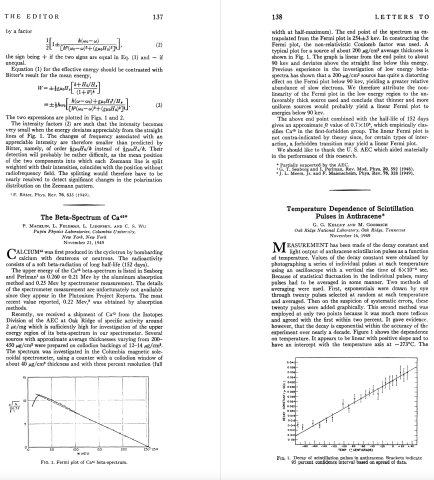
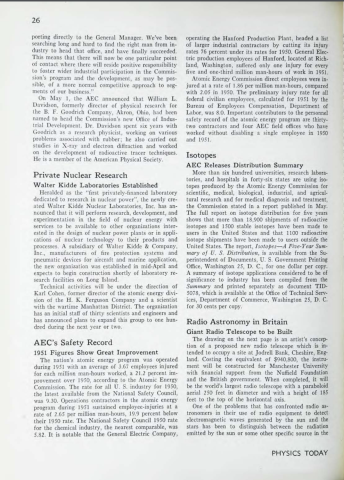
Stan worked there between 1955-56.
Heralded as the "first privately-financed laboratory dedicated to research in nuclear power", the newly created Walter Kidde Nuclear Laboratories, Inc. has announced that it will perform research, development, and experimentation in the field of nuclear energy with services to be available to other organizations interested in the design of nuclear power plants or in applications of nuclear technology to their products and processes.
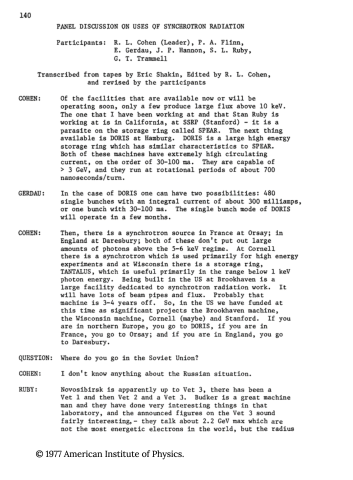
Mössbauer measurements of Fe57 were made on ferromagnetic Fe4N, which has a face-centered cubic arrangement of iron atoms with nitrogen at the body-center position. The hyperfine fields are 345 koe for the corner Fe and 215 koe for the three face-center Fe, approximately proportional to their magnetic moments, 3μB and 2μB. The isomer shifts, measured against a stainless steel source, are 0.30 mm/sec for the corner Fe and 0.45 mm/sec for the face-center Fe. These values are in line with their proposed electronic configurations of 3d74s and 3d84s, which are derived on the assumption that the nitrogen at the body-center position acts as an electron "donor" to the face-center Fe. The Mössbauer spectra of (Fe3.6,Ni0.4)N and (Fe3Ni)N are consistent with their ordered structures in which Ni replaces the corner Fe preferentially.

Garwin's dissertation was in beta-gamma angular correlation. He later consulted with Wu about the errors in the Rustad-Ruby experiment.
The beta-gamma angular correlation was investigated in the isotopes Na24, Co60, Ru103, Gd115, Ir192, and Au198. Measurements were made at ten angles between 45 to 180 degrees. No departure from spherical symmetry was found in any case, within the statistical error (standard deviation 1% or 2% in most cases). Tests and arguments are set forth to establish that the lack of correlation exists in fact at the atom and probably at the nucleus itself. The discrepancy between the results of this experiment and the predictions of the beta ray theory is discussed.
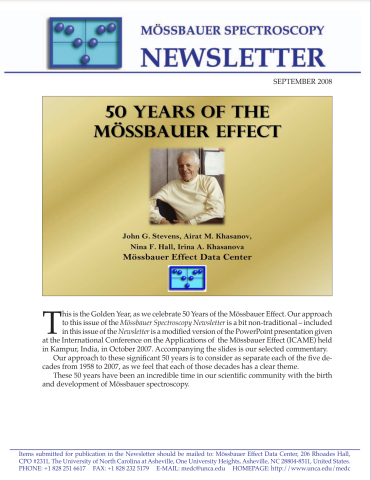
Readable history of Mossbauser science with numerous Stan Ruby mentions
This is the Golden Year, as we celebrate 50 Years of the Mössbauer Effect. Our approach to this issue of the Mössbauer Spectroscopy Newsletter is a bit non-traditional – included in this issue of the Newsletter is a modified version of the PowerPoint presentation given at the International Conference on the Applications of the Mössbauer Effect (ICAME) held in Kampur, India, in October 2007. Accompanying the slides is our selected commentary. Our approach to these significant 50 years is to consider as separate each of the five decades from 1958 to 2007, as we feel that each of those decades has a clear theme. These 50 years have been an incredible time in our scientific community with the birth and development of Mössbauer spectroscopy.
In the mid-1960s, a new phase began at Argonne when Michael Kalvius was recruited to the Solid State Science Division. By this time, Stan Hanna had left the Physics Division at Argonne and had been replaced by Stan Ruby. Ruby and Kalvius began working together and, during the next few years, their collaboration expanded to include two young solid-state physicists, Bobby Dunlap and Gopal Shenoy. Shenoy would remember later that they measured about 10,000 compounds during the Great Mössbauer Expansion period.
In the mid-60’s Stan Ruby approached Irwin Gruverman of NENC, the New England Nuclear Corporation, suggesting that NENC sponsor a one-day Mössbauer Effect Methodology conference (MEM) in association with the winter meeting of the APS. NENC had become a principal supplier of radionuclides and ME sources and absorbers here and abroad. The series began on January 26, 1965, in New York City with free registration for all 250 participants. The 15 papers were presented in an afternoon/evening format. As needed, NENC paid the expenses of the chosen speakers, who generally were from labs in the USA. A pre-Symposium dinner the night before the presentations became an effective vehicle for the speakers and the organizers to meet each other. Manuscripts were published in Mössbauer Effect Methodology Volume 1 (through Volume 10) by Plenum Press, New York, edited by I. Gruverman.
With the prodding and support of Stan Ruby, the Mössbauer Effect Data Center was established at the University of North Carolina at Asheville with a modest grant of $2,800 from the North Carolina Board of Science and Technology. The resources of Argonne National Laboratory were made available during these early years at the Center. Other funding during this time came from the National Bureau of Standards’s National Standard Reference Data Systems and the National Science Foundation, In 1969, MEDC developed one of the first databases used in the scientific community using IBM Assembler code.

The history of the flowering of the Columbia Physics Department under I. I. Rabi is recounted in Chapter 13.
Stan loved Christmas and he delighted in spoiling us kids. I guess it went back to his own father, but the Rubys always celebrated the joyous holiday, despite its Christian origin.
But if he would say "Merry Christmas" sincerely in late December, on occasion he used the expression the rest of the year in a sarcastic manner, suggesting perhaps that anti-Semitism could be at play in some situation.
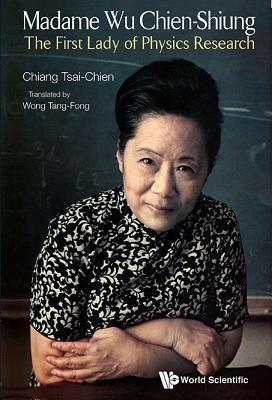
Originally published in Chinese in 1996. Stan Ruby was interviewed and is cited as a source. Wu's involvement in the Rustad-Ruby affair is documented.
Narrating the well-lived life of the "Chinese Madame Curie" -- a recipient of the first Wolf Prize in Physics (1978), the first woman to receive an honorary doctorate from Princeton University, as well as the first female president of the American Physical Society -- this book provides a comprehensive and honest account of the life of Dr Wu Chien-Shiung, an outstanding and leading experimental physicist of the 20th century.
In the early 1950s, two of Wu's students, S. Ruby and B. Rustad, performed an experiment to investigate the beta decay in the transition from radioactive helium (He-6) to lithium (Li-6).
Wu held discussions with the students during the experimental process. The students published a short article in Physical Review Letters in 1952, followed by a long article in the Physical Review in 1955. They determined that the Fermi theory had a scalar (S) transition matrix, and the Gamow-Teller theory had a tensor (T) transition matrix.
As their experiment had Wu's endorsement, and she had a long record of precision, the Ruby-Rustad papers initially carried a lot of credibility. Later experiments, however, showed conflicting results.
Richard Feynman, M. Gell-Mannn (who won the Nobel Prize for a proposal of "quarks" and their interactions), R. Marshak and his student E. Sudarshan, and another physicist, J. Sakurai, all argued that the transition matrices in begta decay were vector (V) and axial vector (A). Before this was settled, some said that Marshak must be mad. How could the He-6 experiment be wrong?
Not long afterward, Maurice Goldhaber and two collaborators did an elegant experiment and proved that the V-A theory was correct. That settled the dispute.
Wu was very unhappy about the mistake made in the experiment of Ruby and Rustad. Ruby discussed the experiment in the Plaza Hotel (a landmark in New York City where Chiang Ching=Kuo, then Vice-Premier and later President of Taiwan, was shot while visiting the US) in January 1990, and regretted that he was so careless. He did not finish his Ph.D. degree, worked for IBM for some time, and resumed research work at Stanford University. Rustad died in the early 1960s.
The incident bothered Wu, She later built a larger experimental setup at Columbia, and did a similar experiment with He-6/ She and her collaborator Arthur Schwarzchild wrote a paper in 1958 pointing out the factors causing the mistake in the earlier experiment.
This bad mark did not change very much the position of authority in the field of beta decay that Wu enjoyed. Her reputation as the most precise experimentalist was intact. The saying in the physics circle was: “If the experiment was done by Wu, it must be correct.” [H. Schopper]